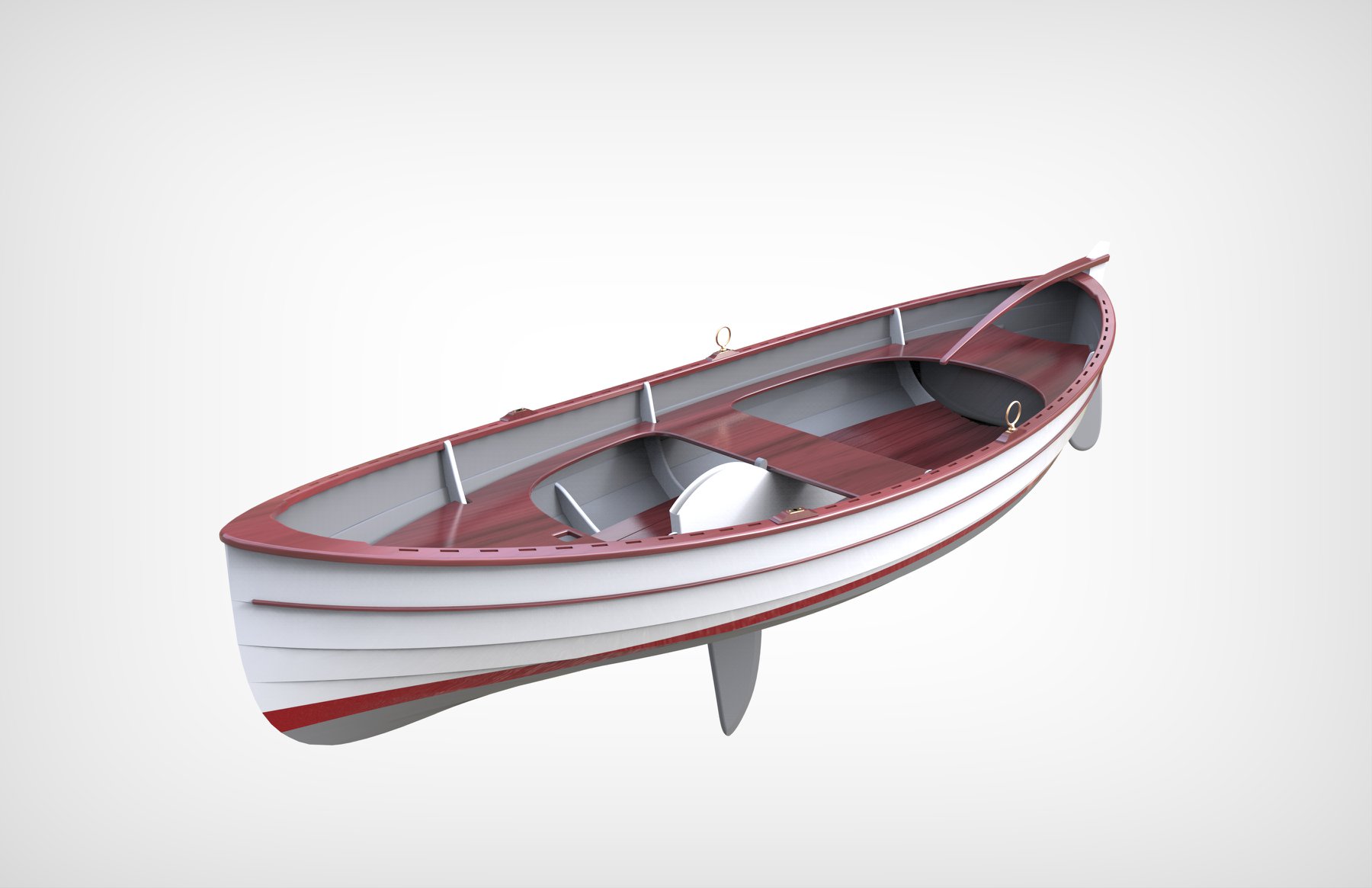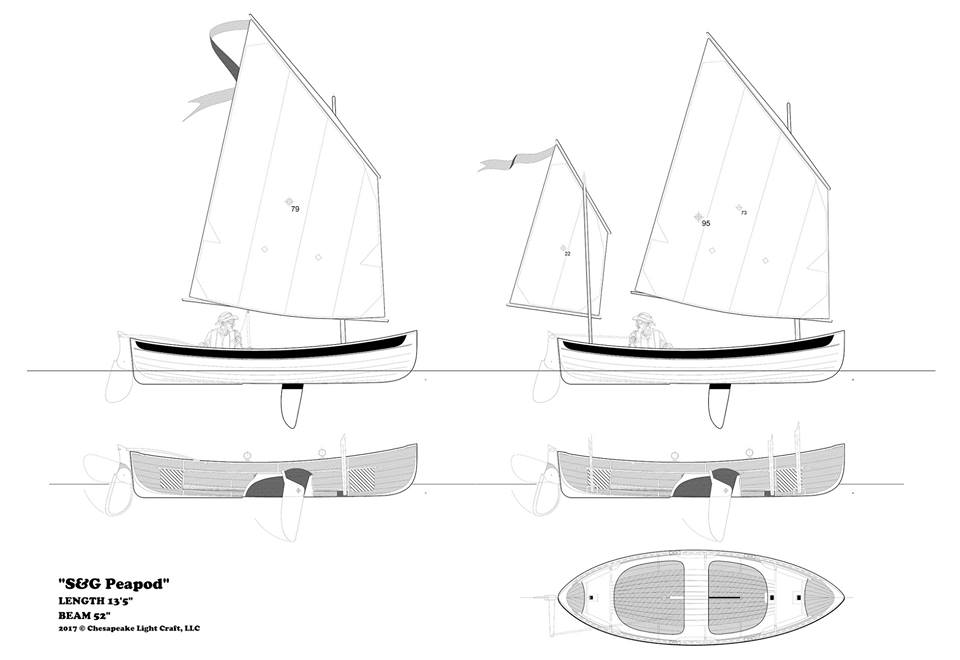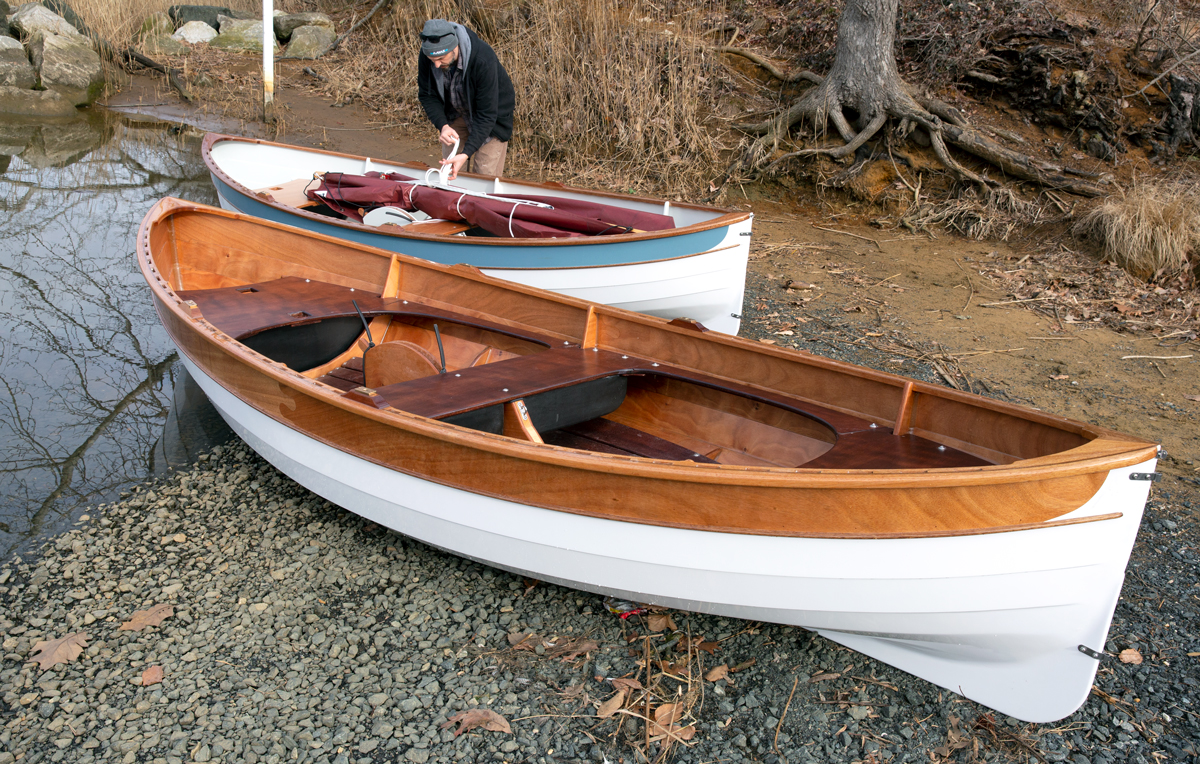This design is modeled on the "peapods" indigenous to Maine. "Peapod" is a somewhat amorphous term for a double-ended rowing-sailing boat, used for inshore lobstering, fishing, and general utility such as tending lighthouses. Thus the design name: Lighthouse Tender. Designer John C. Harris was inspired by the "Old Sailing Peapod" from Washington County, Maine, detailed in American Small Sailing Craft, Howard Chapelle's indispensable reference work of traditional designs. The boat in American Small Sailing Craft was built "about 1886" and its hull shape recorded by Chapelle in 1937.
A good peapod is stable enough to allow the crew to stand and retrieve heavy lobster pots over the side. Rowing qualities are central to the design, but sailing rigs were added whenever much distance needed to be covered. Stable and easily driven, they make fine sailboats. Traditional working peapods were extinct by the 1960's, but thanks to Chapelle and others the type found a new life as a pleasure boat.
A traditional peapod is really hard to build. It took John Harris the better part of 20 years to translate the Maine peapod's subtlety of shape and character into a design that can be built easily using stitch-and-glue techniques, without a complicated mold or complex joinery.
"You'd never guess it, but the Skerry design was my first hack at a peapod, way back in 2000," John says. "At the time, however, getting plywood to bend into such a complex shape was out of reach of available design technology. Instead, the Skerry developed into a cousin of the round-sided dory---a simpler, though no less attractive shape. It was a happy accident, as the Skerry ended up really light and really quick to build, like a dory, and became one of the most popular boat kits of all time."
CAD/CAM has come a long way, meanwhile, and John remarks, "We've gotten a lot smarter." CLC's new Tenderly Dinghy was the big breakthrough, John says. "The Tenderly Dinghy can be stitched-and-glued by most first-time boatbuilders, yet there isn't the slightest compromise in that boat's traditional hull shape for the sake of construction ease. It's an absolutely free-form shape, unconstrained by the need to be shipped out as a pre-cut boat kit. Show a Tenderly Dinghy to a professional boatbuilder unfamiliar with the design, and they'll assume it was assembled using complex traditional techniques."
Before the 100th Tenderly Dinghy kit had shipped, John was convinced that he could have his stitch-and-glue peapod at last. In many respects, the new peapod design is a Tenderly Dinghy with a pointed stern instead of a transom. After some tinkering, the prototype Lighthouse Tender was built at CLC, and another during a class at the WoodenBoat School during 2018. Both hulls were finished at CLC while cameras snapped pictures for the instruction manual.
The Lighthouse Tender rows and sails beautifully, upwind and down. It's stable and, like its traditional forebears, carries a heavy load. Though the Lighthouse Tender is 18" shorter than the Skerry, its payload is 45% larger, at 650lbs.

As seen in WoodenBoat Magazine #277
Frequently Asked Questions:
What is a peapod?
There's no firm definition, but the name refers to small doubled-ended rowing and sailing boats used for fishing and utility work in Maine. Most were 13-18 feet long. Peapods are most famous as inshore lobstering boats, the fisherman rowing standing up and facing forward. Peapods had to be stable enough that heavy lobster pots could be retrieved over the side.
What is the Lighthouse Tender Peapod's payload?
About 650 pounds set up for rowing. About 75 pounds less for sailing.
Can I install an engine?
No. This is a double-ended boat. There is no provision for an outboard engine or otherwise.
There are two sailing rig options. Which should I choose?
You can rig the Peapod with a single lug sail, or as a lug-rigged cat yawl with two masts. A full year of testing in all conditions suggests that there's effectively no difference in performance between the two rigs. The single lug sail might be slightly faster upwind in light air; the cat yawl might be slightly faster offwind in heavy air, though in practice the differences are very small.
The advantage of the single sail is simplicity of rigging, fewer spars to build, less weight and windage, and faster setup at the beach.
The cat yawl is easier to "heave to" in rough conditions and allows very fine-tuned sailing balance. The mizzen is a nice "riding sail" at anchor or in a squall. It's very easy to shorten sail in the yawl by stowing the mizzen mast and moving the main mast back to the middle mast step. The two masts also make it a cinch to rig a tent over the cockpit for camp-cruising.
How well does the Lighthouse Tender sail?
These boats are a treat to sail in all conditions, stable yet fast, well-balanced and easy on the helm. A cruising speed of around 5 knots has been observed in 10-12 knots of wind, an excellent showing for a 13'5" boat.
Does the centerboard pivot if you hit something?
Yes. The Peapod has a traditional pivoting centerboard. The rudder will also "kick up" for shallow water operations.
Where do you sit?
On the thwarts while rowing. Mostly on the floorboards while sailing. Hiking is not necessary, though the crew will shift their weight to windward in tacking.
What are the plans and manual like if I want to build from scratch instead of from a kit?
Plans comprise full-sized patterns for every part in the boat. Both sailing options are included in all plans packages. The manual includes hundreds of step-by-step photos and diagrams covering every step. Plans builders should be comfortable with a variety of power tools.
Can you send me the plans digitally?
Sorry, until digital rights management technology for architectural work catches up to books and music, we are unable to transmit digital data, only paper plans and manuals.
Can I fit a sliding seat for rowing?
Not in this boat. It's a bit too short to benefit from a sliding seat, and the centerboard trunk would interfere with the installation of the seat.
Can two people row in tandem?
While two rowing positions are indicated, these are meant to allow the crew to trim the boat with one, two, or three people aboard. Only one person will be rowing at a time.
How much does the Lighthouse Tender Peapod weigh?
The stripped hull is about 160 pounds. Fully rigged and with gear aboard, the weight is around 220 pounds.
Can I cartop this design? What sort of trailer do I need?
Four adults could load a boat of this weight onto a heavy vehicle for cartopping, but as a practical matter the Lighthouse Tender Peapod should be transported on a trailer. The smallest, lightest trailer is plenty. Currently we carry our display model on a Trailex SUT-350.
Can I build the Lighthouse Tender in one of your build-your-own classes?
Alas, no. It's too big a project for the one-week class format. The classes get you through about 45 hours of construction, which is enough to complete major assembly of smaller, simpler boats like the Skerry and many of our other smallcraft. The Peapod's parts-count is just too high to be a good fit with the 5-1/2-day classes.
How long does it take to build this boat?
Expect to spend about 200 hours building a Lighthouse Tender Peapod with a yacht finish.
How skilled do I need to be to build my own Lighthouse Tender Peapod?
Patient first-time boatbuilders who have some experience with epoxy and fiberglass will do fine with the Lighthouse Tender, especially working from a pre-cut kit. We have gone to tremendous lengths to simplify assembly without compromising the boat's appearance or function. Most builders will probably have built something smaller like a kayak or a dinghy before taking on this project.
How does this 13'5" LapStitch™ double-ender differ from the Skerry, your 15'0" LapStitch™ double-ender?
The Skerry is much, much lighter and has a lower parts-count. The Skerry has a payload of 450lbs compared to the Lighthouse Tender's 650lbs. The Skerry is less stable. The Lighthouse Tender also comes standard with more small-boat amenities, including a pivoting centerboard, "spacered inwales," and spiled floorboards.
"Seaworthiness" is a slippery term, but all things being equal, the Lighthouse Tender Peapod is more "seaworthy." It depends on the skill of the crew, of course. Caught in rough conditions, a skipper with sophisticated small boat sailing skills will be safer in the Skerry than a beginner will be in the Peapod…
The Skerry is longer; why is it cheaper than the Peapod?
Parts count, that's all. Plus, "length" is not "size." A Skerry has about half as many parts. Compare an image of the Lighthouse Tender Peapod's kit to the Skerry's kit.

CLC's peapod has all of the subtle shape of a good Maine peapod, and it's lovely to row.

Rig options include either a single balanced lug sail or a cat-yawl rig with two lug sails.

A traditional pivoting centerboard is standard, and the rudder kicks up.

All versions will include three mast steps, allowing numerous rig options.

Need more wind for photos!

In this photo, the boat is displacing about 810lbs.


The sterns of the two prototypes are closest to the photographer, showing the big skeg for solid tracking while rowing.